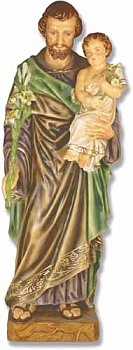Mention must be made at this site of the custom of burying a
statue of
St. Joseph in order to sell a home you place on the market.
The custom hearkens back at least to the great St. Teresa of Avila
(A.D. 1515 - 1582), foundress of the Disalced Carmelite Order. As her
Order spread, a new convent had to be built, and in order for a new
convent to be built, land must be had. When the nuns found a particular
piece of land that was perfect for their purposes, they also found that
their coffers weren't full enough to purchase it, so they decided to
ask the intercession of St. Joseph, burying medals imprinted with his
likeness in the ground of the desired property as a sign of their
prayers. It worked.
It also worked for Blessed Brother André Bessette, who was able to get
the land on which he built the Shrine of St. Joseph of Mount Royal, in
Montreal, Canada by praying to St. Joseph and burying a St. Joseph
medal on the grounds of the future site as a sign of his prayers.
It worked, too, for Mother Cabrini
when she wanted to acquire an elite
boys' school in New York. She was told the school was not for sale, but
buried a St. Joseph medal surreptitiously as she left -- and a few days
later, was able to make arrangements to buy it.
Now, these events deal with acquiring land, not selling
it, and they deal with St. Joseph medals, not St. Joseph statues.
Nonetheless, over time, the folk custom came to be for sellers of
homes to bury a statue of St. Joseph as a sign of prayer asking
to find a buyer and hasten the sale.
How it's done
Most commonly, a
statue of St. Joseph is placed inside a protective cloth and buried
upside-down in the front yard. People differ as to whether the statue
should be upside-down or right side-up, and whether the yard should be
the front yard or back yard, but worrying about such things is
unecessary.
Then a prayer to St. Joseph is said. One sadly popular, "kitschy"
version of a prayer for this purpose is:
Oh, St. Joseph,
guardian of household needs, we know you don't like to be upside down
in the ground, but the sooner escrow closes the sooner we will dig you
up and put you in a place of honor in our new home. Please bring us an
acceptable offer (or any offer!) and help sustain our faith in the real
estate market.
Ahem! What kind
of way is that to talk to the earthly Father of Our Savior? If one
thinks St. Joseph doesn't like for his statue to be buried in the
ground, one shouldn't bury it! This so-called "prayer" not only calls a
statue "you" as if it were the Saint himself, but it sounds more like a
ransom note than a humble beseeching -- "St. Joseph, we gotcha right
where we want ya. We know ya hate it in the
ground, see, but if ya want out, ya better come up with the
goods, capisce?" Sheesh! Truly, if one decides to bury a statue (or
medal, in the older way), a sincere and humble prayer would definitely
be the only way to go. How about this simple prayer?
Memento nostri,
beate Ioseph, et tuae orationis suffragio apud tuum putativum Filium
intercede; sed et beatissimam Virginem Sponsam tuam nobis propitiam
redde, quae Mater est Eius, qui cum Patre et Spiritu Sancto vivit et
regnat per infinita saecula saeculorum. Amen.
English version:
Be mindful of us, O Blessed Joseph, and intercede for us with thy
foster-Son by the pleading of thy prayer: do thou, in like manner,
render the blessed Virgin Mary, thy Spouse, gracious unto us, for she
is the Mother of Him, Who with the Father and the Holy Ghost liveth and
reigneth world without end. Amen.
Anyway, when the
house is sold, God and St. Joseph are thanked, the statue is dug up and
given a place of honor in your new home, and you, of course, tell
others about the power of St. Joseph's intercession.
Is this custom superstitious? It is if one doesn't
believe in
the intercession of Saints and the good of making outward signs of
prayer. Given that two million St. Joseph home-selling kits are
sold each year -- even to Protestants and
pagans -- I imagine that most people who practice this custom do
superstitiously bury the statues for a sense of "luck" more than
anything. But that doesn't make the practice bad in itself, not when
it's done properly: with sincere prayer, giving St. Joseph a place of
honor in your new home, and telling others of the wonders of this great
Saint.

A note from a
site visitor:
This does work!
My wife and I buried a small St Joseph statue in our back yard after 3
months of fruitless effort in selling our home. Shortly after, we were
getting traffic through our home and did eventually sell our home. The
timing was perfect because the home we were buying was contingent on
this sale as well as that home's sale was contingent, too! St Joseph
truly came through for us. As an aside, a year later I was digging in
my garden and who did I find................. yes, the previous owner's
St Joseph. We're keeping him and he's keeping us.
|

